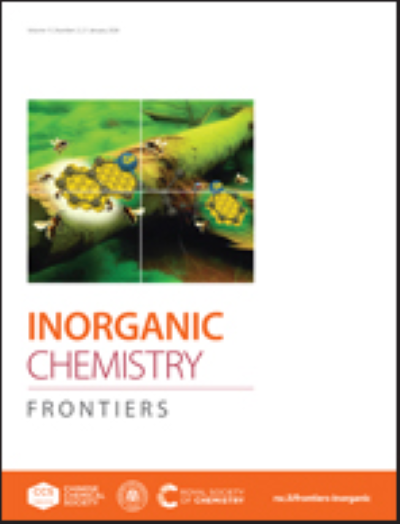Bioorthogonal activation and mitochondrial targeting of a near-infrared-emitting iridium(III) nitrone complex via cyclooctynylated phosphonium cations for enhanced cellular imaging and photodynamic therapy
IF 6.4
1区 化学
Q1 CHEMISTRY, INORGANIC & NUCLEAR
引用次数: 0
Abstract
In this work, we designed and synthesised a new cyclometallated iridium(III) nitrone complex [Ir(bpz)2(bpy-nitrone)](PF6) (1) (Hbpz = benzo[a]phenazine; bpy-nitrone = 4-((methyl(oxido)imino)methyl)-4’-methyl-2,2’-bipyridine) as a bioorthogonally activatable phototheranostic agent. Complex 1 displayed very weak emission and singlet oxygen (1O2) photosensitisation in solutions due to the quenching nitrone moiety. However, upon the strain-promoted alkyne–nitrone cycloaddition (SPANC) reaction with bicyclo[6.1.0]non-4-yne (BCN), which converted the nitrone unit to a non-quenching isoxazoline derivative, the complex exhibited a substantial increase in emission intensity in the near-infrared region and 1O2 generation efficiency. Given that mitochondria are a crucial target in cancer therapy, we prepared a series of BCN-functionalised phosphonium cations (BCN-Phos-n), each bearing different substituents, to serve as mitochondrial-targeting vectors for delivering complex 1 to the mitochondria via the bioorthogonal SPANC reaction. Notably, complex 1 exhibited more significant emission turn-on upon reaction with BCN-Phos-5 and BCN-Phos-6 (I/Io = 24.7 and 14.1, respectively), attributed to their increased hydrophobicity resulting from the methylation or methoxylation of the phenyl rings on the phosphonium cation. Live-cell confocal imaging and flow cytometric analyses revealed that complex 1 showed larger emission enhancement in HeLa cells pretreated with BCN-Phos-5 or BCN-Phos-6 compared to other BCN-Phos-n analogues. Co-staining experiments confirmed that the resultant luminescent isoxazoline cycloadducts predominantly accumulated in the mitochondria. Additionally, both dark and light-induced cytotoxicity of complex 1 increased upon pretreatment of the cells with BCN-Phos-5 or BCN-Phos-6. Our results demonstrate that the theranostic potential of transition metal nitrone complexes can be significantly enhanced via strategic structural manipulation of their bioorthogonal reaction partners.近红外发射铱(III)硝基酮复合物的生物正交激活和线粒体靶向,通过环辛基化磷阳离子增强细胞成像和光动力治疗
在这项工作中,我们设计并合成了一种新的环金属化铱(III)硝酮配合物[Ir(bpz)2(bpy-nitrone)](PF6) (1) (Hbpz =苯并[a]非那嗪;Bpy-nitrone = 4-((甲基(氧化)亚胺)甲基)-4 ' -甲基-2,2 ' -联吡啶)作为生物正交活化的光治疗剂。配合物1在溶液中表现出非常弱的发射和单线态氧(1O2)光敏性,这是由于氮的猝灭部分。然而,在与双环[6.1.0]非4-炔(BCN)进行应变促进的炔-硝基环加成(SPANC)反应后,该配合物将硝基单元转化为非淬灭的异恶唑啉衍生物,在近红外区域的发射强度和1O2生成效率大幅提高。鉴于线粒体是癌症治疗的关键靶点,我们制备了一系列具有不同取代基的bcn功能化磷离子(BCN-Phos-n),作为线粒体靶向载体,通过生物正交SPANC反应将复合物1传递到线粒体。值得注意的是,配合物1在与BCN-Phos-5和BCN-Phos-6 (I/Io分别为24.7和14.1)反应时表现出更显著的发射开启,这是由于磷离子上苯基环的甲基化或甲氧基化增加了它们的疏水性。活细胞共聚焦成像和流式细胞分析显示,与其他BCN-Phos-n类似物相比,BCN-Phos-5或BCN-Phos-6预处理的HeLa细胞中复合物1显示出更大的发射增强。共染色实验证实,所产生的发光异恶唑啉环加合物主要积聚在线粒体中。此外,BCN-Phos-5或BCN-Phos-6预处理细胞后,复合物1暗和光诱导的细胞毒性均增加。我们的研究结果表明,过渡金属硝基配合物的治疗潜力可以通过对其生物正交反应伙伴的战略性结构操纵而显着增强。
本文章由计算机程序翻译,如有差异,请以英文原文为准。
求助全文
约1分钟内获得全文
求助全文
来源期刊

Inorganic Chemistry Frontiers
CHEMISTRY, INORGANIC & NUCLEAR-
CiteScore
10.40
自引率
7.10%
发文量
587
审稿时长
1.2 months
期刊介绍:
The international, high quality journal for interdisciplinary research between inorganic chemistry and related subjects
 求助内容:
求助内容: 应助结果提醒方式:
应助结果提醒方式:


